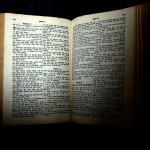This is a hilarious spoof, care of
Bible Review and William Propp of UCSD. Kevin Barney’s recent
Dialogue article reminded me of it, and since it’s the season… enjoy, but do not take seriously!
By William H.C. Propp Bible Review, 14:6 (December 1998)
The ancient Near Eastern roots of American Yuletide customs are manifold and fascinating. I will concentrate here on just two major points: that the Christmas tree was originally a symbol of the Canaanite goddess Asherah and that Santa Claus is an avatar of Asherah’s consort, the high god ‘El, who is equivalent to the Israelite Yahweh. I will conclude by showing that the customs of Christmas were brought to America by the Canaanites themselves.
The coniferous Christmas tree, whether real or stylized (made of metal or plastic), is customarily hung with bright votive offerings: tinsel, metallic globes, colored lights, etc. Small figurines of humans and animals may also adorn the shrub. The custom of decorating a Christmas tree is very old, as shown by a second-century C.E. description of Syrian practice:
Of all the festivals I know about…the greatest is the one they hold at the beginning of [winter].1 Some call it “Fire-Festival,” others “Lamp Festival.” During the festival they sacrifice like this: They chop down large trees and stand them in the courtyard. Then they drive in goats, sheep and other livestock and hang them alive from the trees. In the trees are also birds, clothes, and gold and silver artifacts. When they have made everything ready, they carry the sacred objects around the trees and throw fire in, and everything is immediately burnt.2
Here we find customs still recognizable: selection of a tree, lopping it off at the base and erecting it for a cultic purpose, hanging it with anything valuable, bright or globular—and, finally, burning it as the “Yule log.” Suspending animals, dead or alive, is mercifully no longer customary, although one still finds symbolic reindeer, teddy bears, troll dolls, etc., adorning many a spruce.
Scholars agree that the sacred tree was a symbol of the great ancient Near Eastern Mother Goddess. Many believe that the Israelite God, Yahweh, was no old bachelor, that in fact, he had a consort—the goddess Asherah.3 For example, an inscription on a pithos (large storage jar) from Kuntillet ‘Ajrud in the Negev wilderness reads, “I bless you by Yahweh of Samaria and by his Asherah.”4 My own carbon-14 analysis of the ink yields a date in late December 799 B.C.E.! Evidently the text was a seasonal blessing, a sort of Hallmark card. Asherah’s symbol was a tree, upon which one might hang garments (2 Kings 23:7 mentions that women wove hangings for Asherah). The resemblance to a Christmas tree could not be more striking.
Asherah’s mate, the chief of the Canaanite pantheon, was named ’El, or “the God.” As is generally recognized, the Bible’s descriptions of Yahweh, are heavily influenced by ’El.5
Even a cursory inspection of the traditions surrounding ’El and Yahweh reveal startling connections to our benevolent Christmas spirit Santa Claus. First, as known from Canaanite-Ugaritic literature and art,6 ’El is a white-bearded patriarch7 whose chief epithets are ltpn, “the Compassionate,” and d pid, “Nice Guy.”8 He is associated with dwarf craftsmen (bn amt, “sons of a cubit”)9 and with offerings in the night.10 Israel’s God is also hoary-haired (Isaiah 40:28; Psalms 102:28; Job 36:26; Daniel 7:9) and kindly (“gracious and merciful,” e.g., Exodus 34:6), coming in the night to offer riches to Solomon (1 Kings 3:4–15; 2 Chronicles 1:3–13).11 Like Santa, he is frequently wreathed in smoke (Exodus 19:18; Leviticus 16:2, 13; et al.). Consider, too, the following question, addressed to God: “Who is this coming…dressed in red…why are your garments red, and your clothes like a grapetreader’s?” (Isaiah 63:1–2). Winter in Israel is the somber time, in which, nonetheless, “in all the streets they say, ‘Ho! Ho!’” (Amos 5:16).
Two further features common to ’El/Yahweh and Santa Claus clinch the identification. Both Yahweh and the Canaanite pantheon are said to dwell in yarketey ṣaphon, “the recesses of the North” (Isaiah 14:13; Psalms 48:2).12 Second, ’El is depicted as mounted on a chariot/ throne drawn by winged sphinxes—the cherubim.13 Analogously, Yahweh is known as “he who sits upon the cherubim” (e.g., 1 Samuel 4:4; 2 Samuel 6:2) and is sometimes depicted as flying through the air drawn by or riding such creatures (e.g., Ezekiel 1; Psalms 18:10). Akkadian, the ancient Semitic tongue of Mesopotamia, teaches us the original pronunciation of Hebrew kərûb “cherub”: karibu. Thus, by discerning the Canaanite antecedents of Christmas, we can finally understand why Santa’s vehicle should be drawn by caribou! (The names “Donner” and “Blitzen,” German for “thunder” and “lightning,” also betray the reindeer’s origin as minor Canaanite storm deities.)
Lastly, though the text has been somewhat marred in the course of its transmission, we are able to reconstruct a hymn on Santa’s omniscience, that clearly reflects his divine origin:
He knows if you’ve been sleeping,He knows if you’re awake,He knows if you’ve been bad,
14
So be good for goodness’ sake.
15
Santa Claus, like ’El and Yahweh, is the heavenly judge, meting out rewards and punishments. Every Christmas eve,16 he goes from house to house, assessing human righteousness and, if a household is found worthy, sliding down the chimney to deposit his gracious gifts beneath the boughs of his beloved Asherah.
A loose end in this analysis, I must admit, is the name “Santa Claus” itself. One thing is clear, however: There is no connection with the fourth-century Saint Nicholas, Bishop of Myra, who was not fat, married or particularly generous. Nor did he associate with craftsmen of any stature. My best guess is that “Santa Claus” is a corruption of Semitic *šanta–kulla, “complete year,” or šanta–kalat, “the year is over.” Santa’s iconographic rotundity probably symbolizes the “roundness” of a full year.
If these correlations are valid—and I think their cumulative force is undeniable—how did these antique traditions reach our shores? Archaeologists now know that long before Leif Eriksson and Christopher Columbus, teeming multitudes from the Old World had colonized the New, among them Egyptians, Greeks, Romans, Canaanites and the Ten “Lost” Tribes of Israel. Apparently these last groups bore with them the traditions of Asherah and ’El/Yahweh: the Christmas tree and Santa Claus.
In fact, the very name of our continent, “America,” bears a Semitic etymology—for, as is well known, the connection with the semimythical Amerigo Vespucci is the product of popular but misguided etymology. Rather, “America” recognizably memorializes the ubiquitous seminomads of the ancient Near East who are ancestral to both the Israelites and the Canaanites: the Amorites, who called themselves the Amurru. The derivation of “America” from Amurru follows well-known phonological changes: –urru- > -urri- > -irri- > -erri- > eri, whereupon the Latin gentilic suffix –ica, indicating nationality, was added to the end.
So, before decking the halls with holly—which is originally not a tree, but a type of Middle Eastern festive bread, ḥalla—and before tacking up the mistletoe—which even the nonlinguist may recognize as a corruption of the Hebrew felicitation mazal tov—“congratulations”—why not teach your family the real meaning of Christmas? When you take your kids to meet the mall Santa seated beneath the Christmas tree, let them know before Whom they stand!
Yahweh and his Asherah bless us, every one!
Editor’s Note
When you engage in your favorite Yuletide customs this holiday season—whether it’s decorating the Christmas tree in your living room, arraying the stockings on the mantle in anticipation of a visit from Old Saint Nick or just quaffing a healthy pint of eggnog—you’ll be reenacting centuries-old practices. How can that be, you ask? Our author, the distinguished dilettante William H.C. Propp, reveals the stunning conclusion of his many years of research into his arcane subject: Christmas is a Canaanite holiday! And if you believe him, we have a bridge we’d like to sell you. But can you spot what’s factual in the following article and what’s spoof?—Ed.
William H.C. Propp
William H.C. Propp
William H.C. Propp claims to have advanced degrees from Heidelberg, Salamanca, the Sorbonne and Harvard University in fields ranging from electrical engineering to ancient Near Eastern entymology. None of these institutions, however, lists him among their alumni—although an individual with a similar name owes several thousand dollars in overdue fines to the Harvard University library.
Propp has been acting adjunct assistant lecturer in humanities and social sciences at the San Diego Technical Institute for Biblical Studies and Refrigerator Repair since September 1998. He is currently preparing an exhaustive study of Israelite place-names beginning with the letter gimel.
1 Here I emend the text, which actually says “beginning of spring.”
2 Lucian of Samosata, The Syrian Goddess 49, trans. Harold W. Attridge and Robert A. Oden, Society of Biblical Literature Texts and Translations, Graeco-Roman Religion Series (Missoula, MT: Scholars Press, 1976), pp. 52–55. Because it is composed in Ionic, rather than Lucian’s usual Attic Greek, the work is widely believed to be misattributed. Possibly it was written by Lycias of Sarasota, with whom Lucian is often confused.
3 See my forthcoming study Sex and the Single Godhead. Asherah was also called ’Elah, “the Goddess,” corresponding to ’El, “the God.” Indeed, as ’Elah is to ’El, so Asherah is to Asher, a common title for the God of Israel utterly unknown to scholars. The problem is that ‘asher is generally misunderstood as the relative pronoun “who, that, which.” Once this simple error is corrected, we find the divine name Asher on virtually every page of the Hebrew Bible. Thus, God’s words to Moses in Exodus 3:14, “‘ehyeh ‘asher ‘ehyeh,” mistranslated in the King James Version as “I am that I am,” must really be rendered “I am Asher, I am.” Similarly, the opening of the Decalogue is not “I am the Lord your God who brought you out from the land of Egypt,” but “I, the Lord your God, Asher, brought you out…” Doubtless other examples lurk behind seemingly innocuous “who/what/which’s.” Another source of confusion is the term ‘ashrey, which is generally misinterpreted to mean “how happy!” but which in fact is the majestic dual of ‘Asher. For example, Psalm 84:5 should be translated, not “Happy are those who dwell in your house; they will ever praise you,” but “/Ashrey, those who dwell in your house will ever praise you.” /Asher/Ashrey is ultimately related to Egyptian Osiris and Mesopotamian Asshur (see William F. Albright, “The Evolution of the West-Semitic Divinity ‘An-‘Anat-‘Attâ,” American Journal of Semitic Languages and Literatures 41 [1925], p. 99).
4 For a discussion of the inscription, see Ruth Hestrin, “Understanding Asherah—Exploring Semitic Iconography,”BAR
5 For a popular treatment, see Frank M. Cross, Canaanite Myth and Hebrew Epic (Cambridge, MA: Harvard Univ. Press, 1973), pp. 3–75.
6 Most of our knowledge of Canaanite religion comes from Ugarit (modern Ras Shamra), a coastal city in northern Syria. Ugarit flourished from the 15th century B.C.E. until c. 1200, when it was conquered by the Hittites. The site was rediscovered in 1928 by a Syrian plowman.
7 “You are great, ‘El, you are truly wise; your gray beard truly instructs you” (Michael D. Coogan, Stories from Ancient Canaan [Louisville, KY: Westminster Press, 1978], p. 101; the bearded ’El is portrayed on the cover).
8 Ugaritic was written mostly without vowels. It was a strange language: The word l, for instance, meant “to,” “from,” “yes” and “no”—which probably explains why Ugarit was so easily conquered by the enemy.
9 This translation was definitively established by Albright (“Dwarf Craftsmen in the Keret Epic and Elsewhere in North-west Semitic Mythology,” Israel Exploration Journal 4 [1954], pp. 1–4) and is superior to the more common rendering, “handmaid’s sons.”
10 As in the Ugaritic epic of Kirta, wherein ’El appears to the hero in a dream and offers horses, chariots, riches, etc. For the text, see Coogan, Stories from Ancient Canaan, pp. 52–74.
11 See Choon Leong Seow, “The Syro-Palestinian Context of Solomon’s Dream,” Harvard Theological Review 77 (1984) pp. 141–152.
12 On the role of Mt. Zaphon (modern Jebel ‘el-’Aqra) in Ugaritic mythology, see Coogan, Stories from Ancient Canaan, pp. 13, 22.
13 The image of cherubim as pudgy toddlers reflects classical depictions of the spirits of Love and has no basis in Near Eastern iconography. Scholars agree that cherubs were hybrid beasts, winged lions with human or animal heads. They symbolized the power of the storm. See Albright, “What Were the Cherubim?” Biblical Archaeologist 1 (1938), pp. 1–3, and the accompanying illustrations.
14 The received text continues “or good,” but this is simply a gloss by a copyist who knew a variant, “he knows if you’ve been good,” itself a corruption influenced by the presence of “good” in the following line. Note that my reconstructed version has a more regular meter (3:3:3) than the canonical rendition.
15 Bizarrely, the lost precursor to this text appears to have found its way into Greek literature. Compare Xenophanes, fragment 24, “He sees everything, he knows everything, he hears everything.” On the debt of Xenophanes and other pre-Socratic philosophers to the ancient Near East, see M.L. West, Early Greek Philosophy and the Orient (Oxford: Clarendon Press, 1971).
16 This, too, betrays a Near Eastern origin. Our day, of course, begins at midnight, but the Babylonian and Jewish calendars begin the day at sunset.











